Complete Solutions to MCQ S of chapter FRICTION of Class 11 book with complete answers and questions
| Class 11 | PHYSICS |
| Chapter | FRICTION |
| ERRORLESS | MCQ S |
| Number Of Questions | 100 |
| Academic Year | 2023-24 |
The coefficent of friction `mu` and the angle of friction `lamda ` are related as
01:33View SolutionA force of 98 N is required to just start moving a body of mass 100 kg over ice. The coefficient of static friction is
01:26View SolutionA block weighs W is held against a vertical wall by applying a horizontal force F. The minimum value of F needed to hold the block is
02:15View SolutionThe maximum static frictional force is
01:24View SolutionMaximum value of static friction is .
01:18View SolutionPulling force making an angle `theta` to the horizontal is applied on a block of weight `W` placed on a horizontal table. If the angle of friction is `alpha`, then the magnitude of force is `alpha` , then the magnitude of force required to move the body is equal to
06:25View Solution
In the figure shown, a block of weight 10 N resting on a horizontal surface. The coefficent of static friction between the block and the surface `mu_(s)=0.4` . A force of 3.5 N will keep the block in uniform motion, once it has been set in motion. A horizontal force force of 3N is applid to the block, then the block will02:09View SolutionTwo masses `A` and `B` of `10 kg` and `5 kg`, respectively , are connected with a string passing over a frictionless pulley fixed at the corner of a table as shown. The coefficient of static friction between `A` and the table is `0.2`. The minimum mass `C` that should be placed on `A` to prevent it from moving is equal to
 03:53View Solution
03:53View SolutionThe limiting friction is
01:54View SolutionWhich is a suitable method to decrease friction
01:46View SolutionA uniform rope of length L meters is lying over a table. If the coefficient of friction be `mu`, then the maximum length `L_(1)` of the part of the rope which can overhang the edge without sliding is
06:07View SolutionWhich of the following statements is not true
02:53View SolutionA block of 1 kg is stopped against a wall by applying a force F perpendicular to the wall. If `mu=0.2` then minimum value of F will be
03:37View SolutionA heavy uniform chain lies on a horizontal table-top. If the coefficient of friction between the chain and table surface is 0.25, then the maximum fraction of length of the chain, that can hang over one edge of the table is
05:47View SolutionThe blocks A and B are arranged as shown in the figure. The pulley is frictionless. The mass of A is 10 kg . The coefficient of friction of A with the horizontal surface is 0.20. The minimum mass of B to start the motion will be
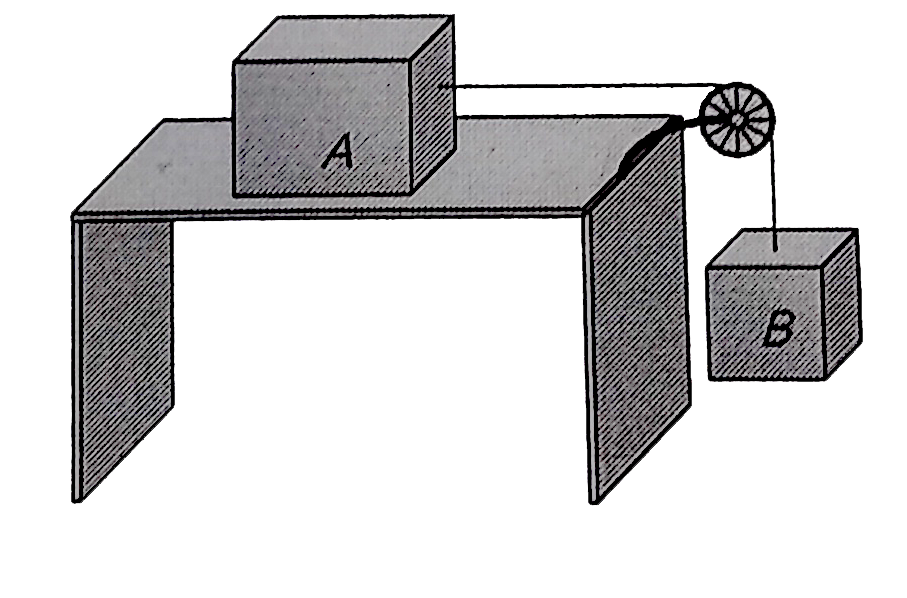 02:39View Solution
02:39View SolutionWork done by a frictional force is
02:11View SolutionL changes partly from a table which is kept in equilibrium by friction. The maximum length that can withstand without slipping is `l` , then coefficient of friction between the table and the chain is
03:48View SolutionWhen two surfaces are coated with a lubricant, then they
01:25View SolutionA 20 kg block is initially at rest on a rough horizontal surface. A horizontal force of 75 N is required to set the block in motion. After it is in motion, a horizontal force of 60 N is required to keep the block moving with constant speed. The coefficient of static friction is
02:50View SolutionA block `A` with mass 100kg is resting on another block `B` of mass 200kg. As shown in figure a horizontal rope tied to a wall hold it. The coefficient of friction between `A` and `B` is `0.2` while coefficient of friction between `B` and the ground is `0.3` . the minimum required force `F` to start moving `B` will be.
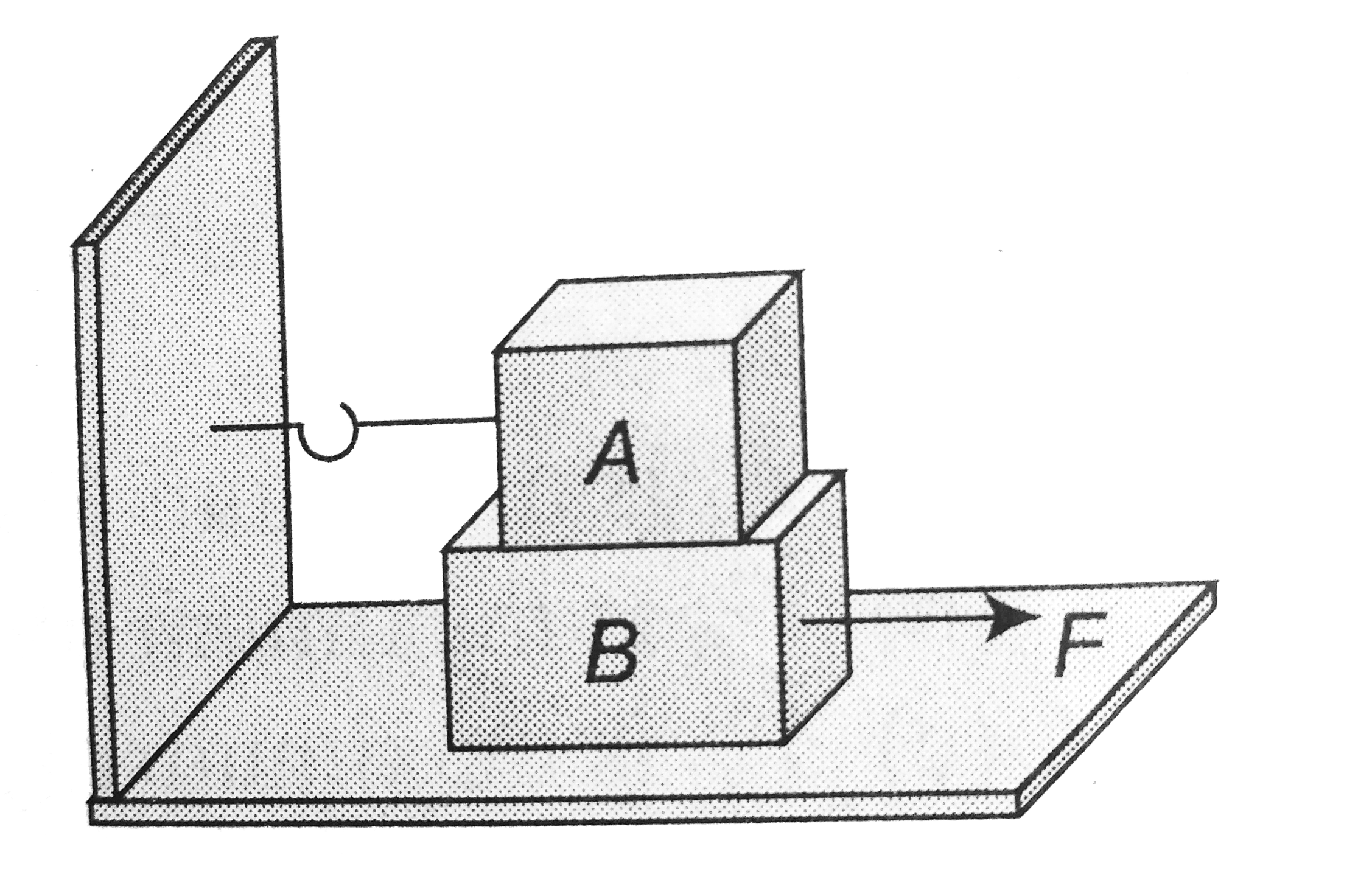 07:48View Solution
07:48View SolutionTo avoid slipping while walking on ice, one should take smaller steps because of the
03:52View SolutionA box is lying on an inclined plane what is the coefficient of static friction if the box starts sliding when an angle of inclination is `60^(@)`
02:25View SolutionA block of mass `2kg` is kept on the floor. The coefficient of static friction is `0.4` . If a force `F` of `2.5N` is applied on the block as shown in the figure, the frictional force between the block and the floor will be.
 02:37View Solution
02:37View SolutionWhich one of the following is not used to reduce friction
02:33View SolutionIf a ladder weighting `250 N` is placed against a smooth vertical wall having coefficient of friction between it and floor 0.3, then what is the maximum force of friction available at the point of contact between the ladder and the floor?
02:06View SolutionA body of mass 2 kg is kept by pressing to a vertical wall by a force of 100 N . The coefficient of friction between wall and body is 0.3. Then the frictional force is equal to
02:15View SolutionA horizontal force of 10N is necessary to just hold a block stationary against as well. The coefficient of friction between the block and the wall is 0.2. The weight of the block is
 02:03View Solution
02:03View SolutionThe coefficient of static friction, `mu_(s)` between block A of mass 2 kg and the table as shown in the figure is 0.2. What would be the maximum mass value of block B so that the two blocks do not move? The string and the pulley are assumed to be smooth and massless.`(g=10m//s^(2))`
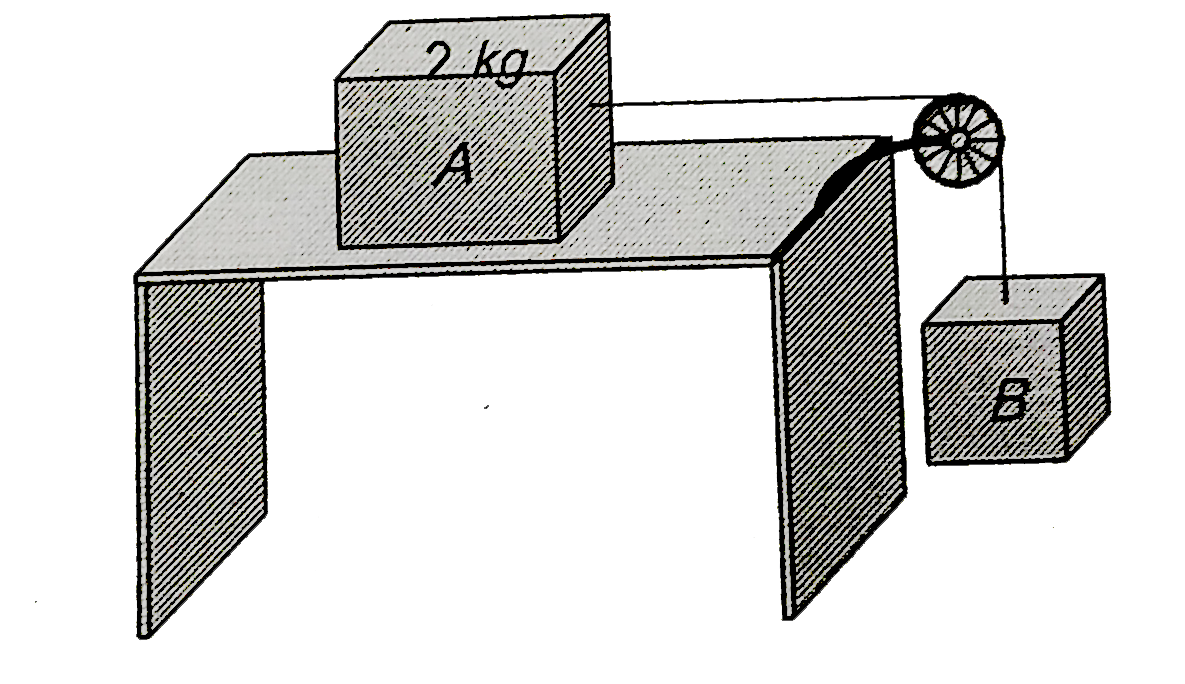 03:45View Solution
03:45View Solution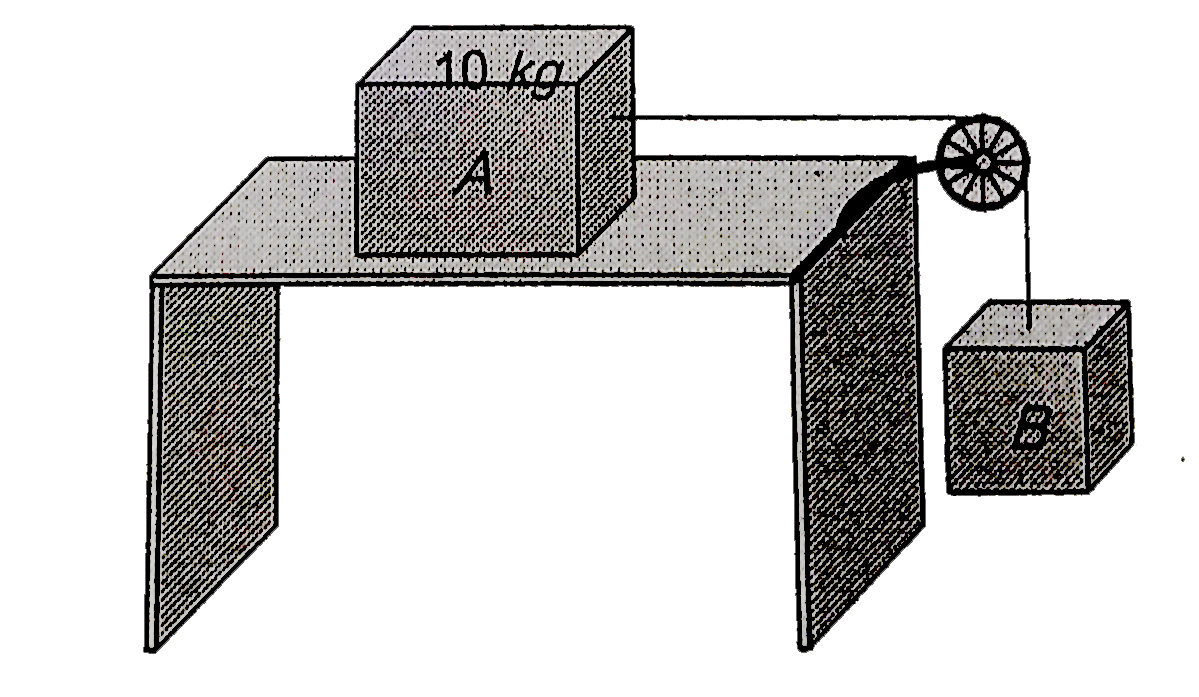
If mass of A=10 kg, coefficent of static friction =0.2 coefficient of kinetic friction =0.2 then mass of B to start motion is02:42View SolutionA uniform metal chain is placed on a rough table such that the one end of chain hangs down over the edge of the table, when one-third of its length hang over the edge, the chain starts sliding. Then the coefficient of static friction is
03:33View SolutionA lift is moving down with an acceleration equal to the acceleration due to gravity. A body of mass `M` kept on the floor of the lift is pulled horizontally If the coefficient of friction is `mu` then the frictional resistance offered by the body is .
01:46View SolutionIf a ladder weighting `250 N` is placed against a smooth vertical wall having coefficient of friction between it and floor 0.3, then what is the maximum force of friction available at the point of contact between the ladder and the floor?
02:06View SolutionWhich one of the following statements is correct
02:19View SolutionThe maximum speed that can be achieved without skidding by a car on a circular unbanked road of radius R and coefficient of static friction `mu` , is
03:04View SolutionA car is moving along a straight horizontal road with a speed `v_(0)` . If the coefficient of friction between the tyres and the road is `mu` , the shortest distance in which the car can be stopped is
03:09View SolutionA block of mass 5kg is on a rough horizontal surface and is at rest. Now a force of 24 N is imparted to it with negligible impulse. If the coefficient of kinetic friction is 0.4 and `g=9.8m//s^(2)` , then the acceleration of the block is
03:28View SolutionA body of mass 2 kg is being dragged with uniform velocity of 2 m / s on a rough horizontal plane. The coefficient of friction between the body and the surface is 0.20. The amount of heat generated in 5 sec is
. `(4.2"joule"//cal and g=9.8 m//s^(2))`
 02:27View Solution
02:27View SolutionTwo carts of masses `200 kg` and `300 kg` on horizontal rails are pushed apart. Suppose the coefficient of friction between the carts and the rails are same. If the `200 kg` cart travels a distance of `36 m` and stops. Then the distance travelled by the cart weighing `300 kg` is : (if both have same initial speed)
 .02:28View Solution
.02:28View SolutionA body B lies on a smooth horizontal table and another body A is placed on B. The coefficient of friction between A and B is `mu`. What acceleration given to B will cause slipping to occur between A and B
03:21View SolutionA 60 kg body is pushed with just enough force to start it moving across a floor and the same force continues to act afterwards. The coefficient of static friction and sliding friction are 0.5 and 0.4 respectively. The acceleration of the body is
02:50View SolutionA car turns a corner on a slippery road at a constant speed of `10 m//s` . If the coefficient of friction is 0.5, the minimum radius of the arc in meter in which the car turns is
02:42View SolutionA motorcyclist of mass m is to negotiate a curve of radius r with a speed v . The minimum value of the coefficient of friction so that this negotiation may take place safely, is
02:15View SolutionOn a rough horizontal surface, a body of mass 2 kg is given a velocity of 10 m / s . If the coefficient of friction is 0.2 and `g=10m//s^(2)`, the body will stop after covering a distance of
02:19View SolutionA block of mass 50 kg can slide on a rough horizontal surface. The coefficient of friction between the block and the surface is 0.6. The least force of pull acting at an
angle of `30^(@)` to the upwawrd drawn ve3rtical which causes the block to just slide is03:16View SolutionA body of 10 kg is acted by a force of 129.4 N if `g=9.8m//sec^2`. The acceleration of the block is `10m//s^(2)`. What is the coefficient of kinetic friction
02:24View SolutionAssuming the coefficient of friction between the road and tyres of a car to be 0.5, the maximum speed with which the car can move round a curve of 40.0 m radius without slipping, if the road is unbanked, should be
01:30View SolutionConsider a car moving along a straight horizontal road with a speed of 72 km / h . If the coefficient of kinetic friction between the tyres and the road is 0.5, the shortest distance in which the car can be stopped is `[g=10ms^(-2)]`
02:37View SolutionA 500 kg horse pulls a cart of mass 1500 kg along a level road with an acceleration of `1ms^(-2)`. ms . If the coefficient of sliding friction is 0.2, then the force exerted by the horse in forward direction is
03:00View SolutionFind the maximum speed at which a car can turn round a curve of `30 m` radius on a level road if coefficient of friction between the tyres and road is `0.4. Take g = 10 m//s^(2)`.
04:35View SolutionA block of mass 50 kg slides over a horizontal distance of 1m. If the coefficient of friction between their surface is 0.2, then work done against friction is (take `g = 9.8 m//s^(2)`) :
02:09View SolutionOn the horizontal surface of a truck `(mu=0.6)` a block of mass 1 kg is placed. If the truck is accelerating at the rate of `5m//sec^(2)` then friction force on the block will be
02:36View SolutionA vehicle of mass `M` is moving on a rough horizontal road with a momentum `P` If the coefficient of friction between the tyres and the road is `mu` is then the stopping distance is .
02:02View SolutionA body of weight 64 N is pushed with just enough force to start it moving across a horizontal floor and the same force continues to act afterwards. If the coefficients of static and dynamic friction are 0.6 and 0.4 respectively, the acceleration of the body will be (Acceleration due to gravity = g)
03:47View SolutionWhen a body is moving on a surface, the force of friction is called
02:33View SolutionA block of mass `10kg` is placed on a rough horizontal surface having coefficient of friction `mu=0.5` . If a horizontal force of `100N` is acting on it, then acceleration of the body will be.
02:41View SolutionIt is easier to roll a barrel than pull it along the road. This statement is
01:42View SolutionA marble block of mass 2 kg lying on ice when given a velocity of `6m//s` is stopped by friction in 10s. Then the coefficient of friction is
03:22View SolutionA horizontal force of 129.4 N is applied on a 10 kg block which rests on a horizontal surface. If the coefficient of friction is 0.3, the acceleration should be
02:26View SolutionA 60 kg weight is dragged on a horizontal surface by a rope upto 2 metres. If coefficient of friction is `mu=0.5` the angle of rope with the surface is `60^(@)`and `g=9.8m//sec^(2),` then work done is
05:08View SolutionA car having a mass of 1000 kg is moving at a seed of 30 metres/sec. Brakes are applied to bring the car to rest if the frictional force between the tyres and the road surface is 5000 newtons,t he car will come to reast in
01:42View Solutionif `mu_(s),mu_(k)` and `mu_(r)` are coefficeints of static friction, sliding friction and rolling friction, then.
01:34View SolutionA body of mass 5 kg rests on a rough horizontal surface of coefficient of friction 0.2. The body is pulled through a distance of 10 m by a horizontal force of 25 N . The kinetic energy acquired by it is `(g=10ms^(2))`
03:04View SolutionA motorcycle is travelling on a curved track of radius 500 m. If the coefficient of friction between road and tyres is 0.5, the speed avoiding skidding will be
03:18View SolutionA fireman of mass 60 kg slides down a pole. He is pressing the pole with a force of 600N. The coefficient of friction between the hands and the pole is 0.5, with what acceleration will the fireman slide down `(g=10(m)/(s^2)`)
02:28View SolutionA block of mass `m=5kg` is resting on a rough horizontal surface for which the coefficient of friction is `0.2` . When a force `F=40N` is applied, the acceleration of the block will be `(g=10m//s^(2))` .
 04:16View Solution
04:16View SolutionA body is moving along a rough horizontal surface with an initial velocity 6m/s m If the body comes to rest after travelling 9 m , then the coefficient of sliding friction will be
03:09View SolutionConsider a car moving on a straight road with a speed of `100m//s`. The distance at which car can be stopped is `[mu_k=0.5]`
02:31View SolutionA cylinder of 10 kg is sliding in a plane with an initial velocity of 10 m / s . If the coefficient of friction between the surface and cylinder is 0.5 then before stopping, it will cover. `(g=10m//s^(2))`
02:55View SolutionWhen a body is lying on a rough inclined plane and does not move, the force of friction
02:16View SolutionWhen a body is placed on a rough plane inclined at an angle `theta` to the horizontal, its acceleration is
02:37View SolutionA block is at rest on an inclined plane making an angle `alpha` with the horizontal . As the angle `alpha` of the incline is increased the block starts slipping when the angle of inclination becomes `theta`. The coefficient of static friction between the block and the surface of the inclined plane is or A body starts sliding down at an angle `theta` to the horizontal. Then the coefficient of friction is equal to
03:34View SolutionA given object taken n time more time to slide down `45^(@)` rough inclined plane as it taken to slide down a perfectly smooth `45^(@)` incline The coefficient of kintic friction between the object and the incline is .
04:04View SolutionThe force required just to move a body up an inclined plane is double the force required just to prevent the body sliding down. If the coefficient of friction is `0.25` , the angle of inclination of the plane is
08:02View SolutionStarting from rest , a body slides down at `45^(@)` inclined plane in twice the time it takes to slide down the same distance in the absence of friction. The coefficient of friction between the body and the inclined plane is
09:36View SolutionThe coefficient of friction between a body and the surface of an inclined plane at `45^(@)` is 0.5. if `g=9.8m//s^(2)`, the acceleration of the body downwards I `m//s^(2)` is
03:24View SolutionA box is placed on an inclined plane and has to be pushed down.The angle of inclination is
02:17View SolutionA force of 750 N is applied to a block of mass 102 kg to prevent it from sliding on a plane with an inclination angle `30^@` with the horizontal. If the coefficients of static friction and kinetic friction between the block and the plane are 0.4 and 0.3 respectively, then the frictional force acting on the block is
04:16View SolutionA block is lying on an inclined plane which makes `60^(@)` with the horizontal. If coefficient of friction between block and plane is 0.25 and `g=10m//s^2`, , then acceleration of the block when it moves along the plane will be
03:28View SolutionA body of mass 100 g is sliding from an inclined plane of inclination `30^(@)`. What is the frictional force experienced if `mu=1.7`.
01:52View SolutionA body takes just twice the time as long to slide down a plane inclined at `30^(@)` to the horizontal as if the plane were frictionless. The coefficient of friction between the body and the plane is
06:27View SolutionA brick of mass 2kg begins to slide down on a plane inclined at an angle of `45^(@)` with the horizontal. The force of friction will be
01:37View SolutionThe upper half of an inclined plane with inclination `phi` is perfectly smooth while the lower half is rough. A body starting from rest at the top will again come to rest at the bottom if the coefficient of friction for the lower half is given by
05:20View SolutionA body is sliding down an inclined plane having coefficient of friction 0.5. If the normal reaction is twice that of resultant downward force along the inclined plane, then find the angle between the inclined plane and the horizontal .
03:19View SolutionA body of mass 10 kg is lying on a rough plane inclined at an angle of `30^(@)` to the horizontal and the coefficient of friction is 0.5. the minimum force required to pull the body up the plane is
04:01View SolutionA block of mass 1 kg slides down on a rough inclined plane of inclination `60^(@)` starting from its top. If the coefficient of kinetic friction is 0.5 and length of the plane is 1 m , then work done against friction is (Take `g=9.8m//s^(2)`)
03:20View SolutionA block of mass 10 kg is placed on an inclined plane when the angle of inclination is `30^(@)`. The block just begins to slide down the plane. The force of static friction is
02:03View SolutionA body of 5 kg weight kept on a rough inclined plane of angle `30^(@)` starts sliding with a constant velocity. Then the coefficient of friction is (assume `g=10m//s^(2)`)
02:41View Solution`300 J`of work is done in slide a `2kg` block up an inclined plane of height `10m`. `Taking g = 10 m//s^(2), work done against friction is
01:15View SolutionA 2 kg mass starts from rest on an inclined smooth surface with inclination `30^(@)` and length 2m. How much will it travel before coming to rest on a frictional surface with frictional coefficient of 0.25
09:07View SolutionA block rests on a rough inclined plane making an angle of `30^(@)` with horizontal. The coefficient of static friction between the block and inclined plane is `0.8` . If the frictional force on the block is `10 N`, the mass of the block in `kg` is `(g = 10 m//s^(2))`
01:54View SolutionA body takes time `t` to reach the bottom of a smooth inclined plane of angle `theta` with the horizontal. If the plane is made rough, time taken now is `2t`.The coefficient of friction of the rough surface is
05:27View SolutionA block is kept on an inclined plane of inclination `theta` of length `l`. the velocity of particle at the bottom of inclined is (the coefficient of friction is `mu`)
05:47View SolutionA block of mass `m` lying on a horizontal plane , is acted upon by a horizontal force p and another force `Q` inclined at an angle `theta` to the vertical .The block will remain in equilibrium if the coefficient of friction between it and the surface is (assume `p gt Q)`
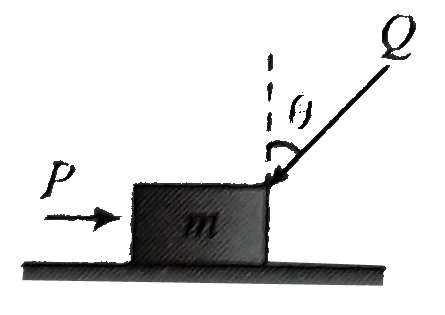 02:30View Solution
02:30View SolutionWhich of the following is correct , when a person walks on the rough surface.
02:18View SolutionA block of mass 0.1 is held against a wall applying a horizontal force of 5N on block. If the coefficient of friction between the block and the wall is 0.5, the magnitude of the frictional force acting on the block is:
04:48View SolutionA body of mass M is kept n a rough horizontal surfasce (friction coefficient `=mu`). A person is trying to pull he body by applying a horizontal force but the body is not moving. The force by the surface on A is F, where
04:12View SolutionWhat is the maximum value of the force F such that the block shown in the arrangement, does not move?
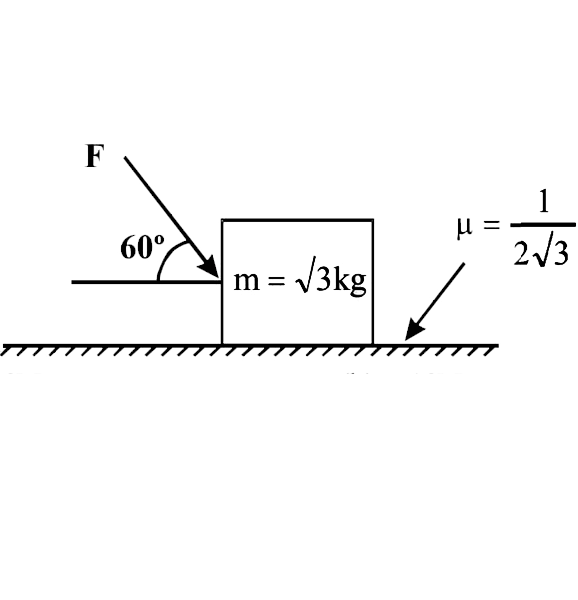 05:42View Solution
05:42View SolutionA block P of mass m is placed on horizontal frictionless plane. A second block of same mass m is placed on it and is connected to a spring of spring constant k, the two blocks are pulled by distance A. Block Q oscillates without slipping. What is the maximum value of frictional force between the two blocks.
 02:45View Solution
02:45View SolutionA block of mass `m` lying on a rough horizontal surface of friction coefficient `mu` is pulled by a force `F` as shown , the limiting friction between the block and surface will be
 02:34View Solution
02:34View SolutionA 40kg slab rests on a frictionless floor as shown in the figure. A 10kg block rests on the top of the slab. The static coefficient of friction between the block and slab is `0.60` while the kinetic friction is `0.40` . The 10kg block is acted upon by a horizontal force 100N. if `g=9.8m//s^(2)` , the resulting acceleration of the slab will be.
 06:50View Solution
06:50View Solution
MCQ S questions and complete solutions for chapter FRICTION of UNIVERSAL BOOK DEPOT 1960 PHYSICS (HINGLISH) of Class 11
